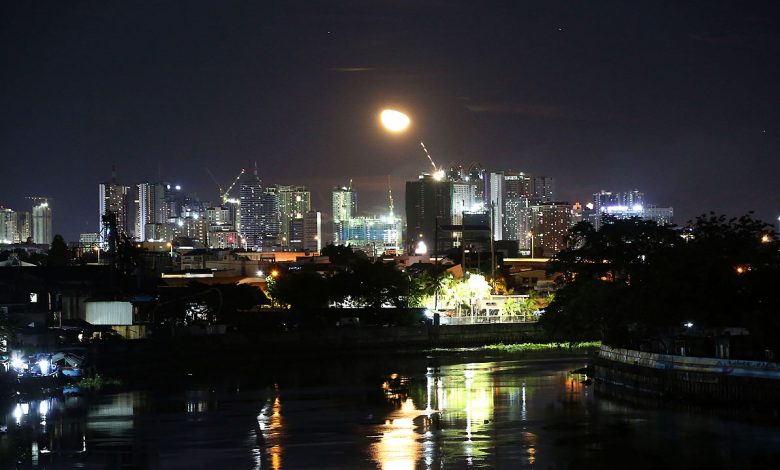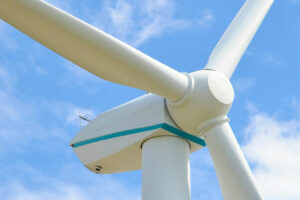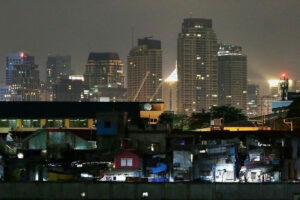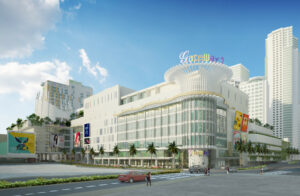BSP bullish on PHL’s ‘full recovery’

The moon is seen beyond the buildings of Mandaluyong City, April 22. — PHILIPPINE STAR/ MIGUEL DE GUZMAN
By Luz Wendy T. Noble, Reporter
THE central bank is confident that the Philippine economy is on track for a “full recovery,” although analysts warned of headwinds from the Russia-Ukraine war and a potential US economic slowdown.
“The Philippines is on its way to full recovery. From a recession in 2020, it bounced back with a 5.7% [growth] last year and we’re looking at a growth rate of 7-9% this year,” Bangko Sentral ng Pilipinas (BSP)Governor Benjamin E. Diokno said in an interview with CNN in Washington.
Government officials earlier said they expect the economy to return to its pre-pandemic level in the second half of 2022. The BSP has said this has been factored in for its decision to keep policy rates unchanged at record lows in March.
Economic activity appears to have gradually improved in the first quarter, despite tighter lockdown restrictions to curb an Omicron-driven surge in January.
Several multilateral institutions recently raised their gross domestic product (GDP) growth projections for the Philippines this year, although still below the government’s 7-9% target.
The International Monetary Fund (IMF) and ASEAN+3 Macroeconomic Research Office both gave a 6.5% GDP growth forecast for the Philippines this year, while the Asian Development Bank expects a 6% expansion. The World Bank is targeting a 5.7% GDP growth for the Philippines this year.
The first-quarter GDP data will be released on May 12.
Mr. Diokno said countries should work together to manage the impact of the war on the supply of staple commodities like oil. He said Middle East economies should consider expanding oil production to ease price pressures.
“There’s really a need for international coordination at this time. There should be a coordinated expansion of output. On the demand side there should also be coordination, how do you reduce energy consumption?” he said.
Headline inflation in the Philippines climbed to a six-month high of 4% in March, reflecting the impact of the oil price surge fueled by the war. The BSP said inflation could breach the 2-4% target range by the second half of the year.
Even after raising its inflation forecast for 2022 to 4.3%, Mr. Diokno has said the BSP is still keen to start raising rates in the second semester.
The BSP will have its next policy review on May 19, while its first rate-setting meeting in the second half is on Aug. 18.
US SLOWDOWN?Meanwhile, economists warned a possible slowdown in the US economy could spill over to Asia-Pacific economies, including the Philippines.
The IMF last week cut its growth outlook for the world’s biggest economy by 0.3 point to 3.7% this year, amid the war in Ukraine.
Former BSP Deputy Governor Diwa C. Guinigundo said the monetary policy tightening in the US could upset financial markets and affect emerging economies.
“There’s a great deal of possibility of capital flight from the Asia-Pacific region including the Philippines. Recession or a simple slowdown in the US economy could affect our exports, BPO (business process outsourcing) and overseas remittances,” he said in a Viber message.
“Setting aside timing, we could find ourselves in a situation where monetary policy might default in arresting the rising inflation and face the prospect of addressing both high inflation and weak economic growth, rather than just doing immediate moderation of price movements and in the process safeguard financial stability and foster the resiliency of the recovery,” he added.
Meanwhile, ING Bank N.V. Manila Senior Economist Nicholas Antonio T. Mapa said slower US growth or a recession will greatly affect the Philippines’ economic trade.
“Slowing demand from a major market like the US would slow overall global trade, which would also negatively impact demand for Philippine products purchased by our other trading partners,” he said.
Bank of the Philippine Islands Lead Economist Emilio S. Neri, Jr. said talk of a possible US recession still seems to be premature.
However, he said the Philippines should be focused on how monetary policy tightening in the US is already affecting the peso’s strength.
“We will have to wait for the implementation of quantitative tightening in the US before we can validate whether yield inversion or other early warnings are going to persist or not. The [US] rate hikes will have to be delivered before we can affirm the possibility of a recession soon,” he said in a Viber message.
The US Federal Reserve will have its policy review from May 3 to 4. It began increasing interest rates by a quarter percentage point in March, and signaled more hikes this year.
Finance Secretary Carlos G. Dominguez III last week said the Philippines would be closely watching the Federal Reserve’s monetary policy normalization before making its own policy adjustments.
“We don’t want to be behind the eight ball here because if the US raises their interest rates, people in the Philippines will, of course, want to follow those rates. We have to make sure we balance the need to grow, the need to fight inflation and the need to preserve our capital,” Mr. Dominguez, who sits on the Monetary Board, said in a Bloomberg Television interview last week.




